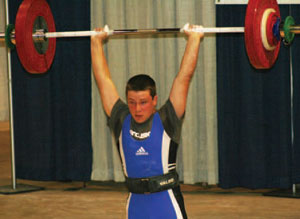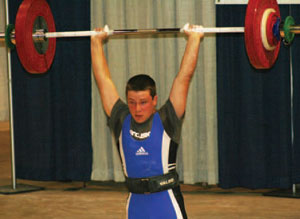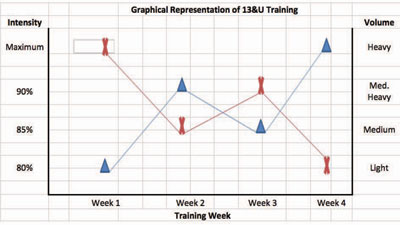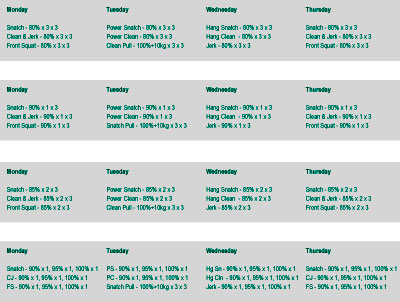13 & Under Weightlifter Training

In last months’ article I outlined the Beginner Training program used at Sandusky Weightlifting. This month I will present to you the transition we make in the second year of training where the training becomes much more structured and from a coach’s perspective, much more detailed. Many coaches prefer to use physiological reasons to justify their training philosophies; I prefer to use numerical reasons in planning and justifying my methods of training, and hopefully that will become apparent in the rest of this article.

A couple reminders before continuing on: Remember in Sandusky we call one year of training one season of training because of our “Weightlifting Season” we schedule every spring. This program works very well in conjunction with Weightlifting Season when contests are held approximately every two weeks. Also, the exercises you see listed here are the only exercises we do on the given program. There are no warm-up exercises or additional supplementary exercises done at the end of the workouts including so-called core work. The lifts themselves provide all the core work needed and therefore are the core of our training.
After one year/season of weightlifting training using the Beginner program detailed in Octobers’ article, the next progression in the series of workouts is the 13&Under training program. Ideally this program would be done for two years—as a 12 and 13 year-old. This program is the first to follow the same pattern that the rest will follow, using four-week rotations with weeks of 80%, 90%, 85% and Maximum. Also, this is the first program to use percentages in training and to track the number of repetitions done per week. The 13&U training also adds a fourth day of training to the week increasing the overall volume and also practice time on the lifts.
Let’s talk about the math behind the program before we get into the actual day-to-day program. As illustrated in table 1.1, weeks 1 and 3 are the repetition heavy weeks with the intensity rather low at 80% and 85%. These weeks are considered to be the skill training weeks and are the weeks that follow a contest in Weightlifting Season. Weeks 3 and 4 are the higher intensity weeks (90% and max) and are the weeks we use going into a contest, local or major. In fact we try to make sure our guys are lifting maximum the week of a major contest (the entire week). We place much stock in the ability to constantly lift heavy weights. Finally the table shows the overall concept of the program with only 31% of the training being done specifically on snatch and clean and jerk the emphasis is still on developing weightlifting specific strength and specific skills. As the lifter matures a shift will begin to occur in the distribution of the repetitions and intensity.
To further illustrate the theory behind the training, observe graph 1.1, which is a graphical representation of table 1.1. This graph takes some getting used to at first, but it can be quite insightful. First it should be noted that I have operationally defined the volume lifted in each week on the right y-axis—‘light’ being the lowest volume and ‘heavy’ being the highest volume. Also, the red X’s are to be read as markers of the volume and the blue triangles are the markers of intensity for the particular week. With this in mind it can then be observed from the graph that in each week the intensity and volume indicators are the inverse of each other. For example in week 1 the intensity is 80% (the lowest) and the volume ‘Heavy’ (the heaviest). This graph will become more important during later phases of training and will be used to track the evolution of the programs.

I will not go into specific details explaining the sets and reps on the program, as it is pretty much self-explanatory, but I will give some of the reasons why the training is planned this way. First off, the bank of exercises has been reduced from twelve exercises to ten—snatch, clean and jerk, front squat, snatch/clean above knee, jerk from rack, power snatch/clean and snatch/clean pulls. Notice the back squat is still missing from the workouts; we do not begin back squatting until the next program. We are taking one more step toward the ultimate goal of training with practically nothing but the lifts and squats.
Second, it should also be noted that we do not do pulls the conventional way. I think that doing pulls and finishing by brushing the bar on the thighs, standing tall and shrugging is more or less a waste of time and a good way to teach inefficient lifting technique. I also do not like doing snatch/clean deadlifts in training because this teaches a stop when the bar should meet the legs and you more or less lose the natural re-bending action of the knees. So when we do pulls we pull it just like a snatch or clean and the bar is brushed along the thighs and then put back down so that the knees still re-bend naturally and there is no standing tall and shrugging and also no stop without a brushing of the bar. Also, the pulls are rotated week from week with the snatch pulls being done during the most intense weeks and the clean pulls done during the rep-heavy weeks.
Third, the percentages for the snatch/clean above knee are taken off of the maximums for the power versions. We do not actually try to lift maximum in the “hang” versions even during the max week it is usually one or two sets a bit above 90% of the power. For simplicity it is listed as 95% and 100%. The hangs are still used to help reinforce speed under the bar as well as learning to push the knees under the bar.
Fourth, the sets and reps outlined (with the exception of the top weights) are merely an example of the jumps that may be taken. They are mostly used from a coaching standpoint to get an approximation of the number of reps being done per week. While most of the time the warm-up sets will reflect what is shown in the program we encourage larger jumps from time to time as a test of will power and skill.
Lastly, I cannot help but to emphasize the level of importance Weightlifting Season has in our training programs. I believe without it I would have a near impossible time achieving the level of commitment I have from my lifters. A sanctioned contest, requiring proper attire, lifting in front of three judges and a crowd, on a competition regulation platform prepares everyone better for major contests. Weightlifting can become a mind-numbing sport if all you do is show up to the same dusty gym day in and day out waiting three months for the next contest. Keep the contests frequent and make focus and top performance priority number one—there is no limit to the results that can be achieved.


A couple reminders before continuing on: Remember in Sandusky we call one year of training one season of training because of our “Weightlifting Season” we schedule every spring. This program works very well in conjunction with Weightlifting Season when contests are held approximately every two weeks. Also, the exercises you see listed here are the only exercises we do on the given program. There are no warm-up exercises or additional supplementary exercises done at the end of the workouts including so-called core work. The lifts themselves provide all the core work needed and therefore are the core of our training.
After one year/season of weightlifting training using the Beginner program detailed in Octobers’ article, the next progression in the series of workouts is the 13&Under training program. Ideally this program would be done for two years—as a 12 and 13 year-old. This program is the first to follow the same pattern that the rest will follow, using four-week rotations with weeks of 80%, 90%, 85% and Maximum. Also, this is the first program to use percentages in training and to track the number of repetitions done per week. The 13&U training also adds a fourth day of training to the week increasing the overall volume and also practice time on the lifts.
Let’s talk about the math behind the program before we get into the actual day-to-day program. As illustrated in table 1.1, weeks 1 and 3 are the repetition heavy weeks with the intensity rather low at 80% and 85%. These weeks are considered to be the skill training weeks and are the weeks that follow a contest in Weightlifting Season. Weeks 3 and 4 are the higher intensity weeks (90% and max) and are the weeks we use going into a contest, local or major. In fact we try to make sure our guys are lifting maximum the week of a major contest (the entire week). We place much stock in the ability to constantly lift heavy weights. Finally the table shows the overall concept of the program with only 31% of the training being done specifically on snatch and clean and jerk the emphasis is still on developing weightlifting specific strength and specific skills. As the lifter matures a shift will begin to occur in the distribution of the repetitions and intensity.
| Week 1 | Week 2 | Week 3 | Week 4 | Ttl/Avg | % of Ttl Rps | |
| Total Reps | 183 | 145 | 167 | 121 | 632 | 100% |
| Classic Lifts Reps | 60 | 40 | 52 | 40 | 196 | 31% |
| Assistance Reps | 123 | 105 | 115 | 81 | 436 | 69% |
| Intensity | 80% | 90% | 85% | 100% |
To further illustrate the theory behind the training, observe graph 1.1, which is a graphical representation of table 1.1. This graph takes some getting used to at first, but it can be quite insightful. First it should be noted that I have operationally defined the volume lifted in each week on the right y-axis—‘light’ being the lowest volume and ‘heavy’ being the highest volume. Also, the red X’s are to be read as markers of the volume and the blue triangles are the markers of intensity for the particular week. With this in mind it can then be observed from the graph that in each week the intensity and volume indicators are the inverse of each other. For example in week 1 the intensity is 80% (the lowest) and the volume ‘Heavy’ (the heaviest). This graph will become more important during later phases of training and will be used to track the evolution of the programs.

I will not go into specific details explaining the sets and reps on the program, as it is pretty much self-explanatory, but I will give some of the reasons why the training is planned this way. First off, the bank of exercises has been reduced from twelve exercises to ten—snatch, clean and jerk, front squat, snatch/clean above knee, jerk from rack, power snatch/clean and snatch/clean pulls. Notice the back squat is still missing from the workouts; we do not begin back squatting until the next program. We are taking one more step toward the ultimate goal of training with practically nothing but the lifts and squats.
Second, it should also be noted that we do not do pulls the conventional way. I think that doing pulls and finishing by brushing the bar on the thighs, standing tall and shrugging is more or less a waste of time and a good way to teach inefficient lifting technique. I also do not like doing snatch/clean deadlifts in training because this teaches a stop when the bar should meet the legs and you more or less lose the natural re-bending action of the knees. So when we do pulls we pull it just like a snatch or clean and the bar is brushed along the thighs and then put back down so that the knees still re-bend naturally and there is no standing tall and shrugging and also no stop without a brushing of the bar. Also, the pulls are rotated week from week with the snatch pulls being done during the most intense weeks and the clean pulls done during the rep-heavy weeks.
Third, the percentages for the snatch/clean above knee are taken off of the maximums for the power versions. We do not actually try to lift maximum in the “hang” versions even during the max week it is usually one or two sets a bit above 90% of the power. For simplicity it is listed as 95% and 100%. The hangs are still used to help reinforce speed under the bar as well as learning to push the knees under the bar.
Fourth, the sets and reps outlined (with the exception of the top weights) are merely an example of the jumps that may be taken. They are mostly used from a coaching standpoint to get an approximation of the number of reps being done per week. While most of the time the warm-up sets will reflect what is shown in the program we encourage larger jumps from time to time as a test of will power and skill.
Lastly, I cannot help but to emphasize the level of importance Weightlifting Season has in our training programs. I believe without it I would have a near impossible time achieving the level of commitment I have from my lifters. A sanctioned contest, requiring proper attire, lifting in front of three judges and a crowd, on a competition regulation platform prepares everyone better for major contests. Weightlifting can become a mind-numbing sport if all you do is show up to the same dusty gym day in and day out waiting three months for the next contest. Keep the contests frequent and make focus and top performance priority number one—there is no limit to the results that can be achieved.

|
Ryan Kyle is the coach of Sandusky Weightlifting and the strength coach for St. Mary's Central Catholic High School in Sandusky, Ohio. He is a USA Weightlifting club coach and his lifters have medaled at the Youth Pan-American Championships and have been Junior World Team members. |
Search Articles
Article Categories
Sort by Author
Sort by Issue & Date
Article Categories
Sort by Author
Sort by Issue & Date

